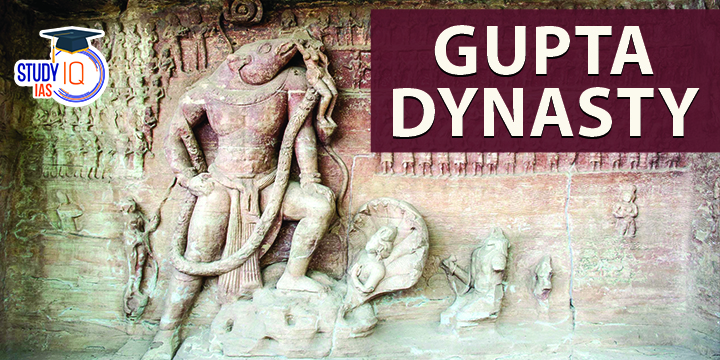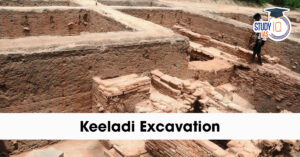Table of Contents
Introduction of Gupta Empire
Two significant political forces—the Kushanas and the Satavahanas in the north and south, respectively—rose to prominence as a result of the collapse of the Mauryan Empire. These two empires supported social harmony and economic development in their respective domains. Around 230 CE, the Kushan rule in north India came to an end, and the Murundas thereafter took control of most of central India (possible kinsmen of the Kushanas).
Murunda rule lasted for just 25 to 30 years. In the last decade of the third century CE, the Gupta dynasty became well-known (about 275 CE). The erstwhile lands ruled by the Satavahanas and Kushanas were mostly under the power of the Gupta Empire. The Guptas (perhaps Vaishyas) maintained political unity in northern India for more than a century (335 CE- 455 CE).
It is believed that the Guptas were Kushana feudators. Uttar Pradesh and Bihar made formed the Guptas’ initial kingdom, which had Prayag as its capital (U.P). The Guptas established their dominance in the prosperous plains of Madhyadesha, also known as Anuganga (the middle Gangetic basin), Saketa (U.P. Ayodhya), Prayag (U.P.), and Magadha (mostly Bihar).
The Guptas took advantage of their closeness to regions in north India that engaged in silk trade with the Byzantine Empire as well as the iron ore riches in central India and south Bihar (eastern Roman Empire). The Gupta era in ancient India is referred to as the “Golden Age” because of the enormous advances made in the disciplines of the arts, literature, science, and technology. The political union of the continent was another outcome.
Founder of Gupta Empire
Chandragupta-I (319 CE – 330/335 CE)
The dynasty’s first significant king and regarded as its true founder was Chandragupta-I (319–330/335 CE). He took on the name “Maharajadhiraj.” His rule extended to areas of Eastern Uttar Pradesh, Jharkhand, and South Bihar (Saketa and Prayaga).
Beginning with his accession in around AD 319–320, the Gupta Samvat was established (era). Gold coins featuring the likenesses of Kumardevi and Chandragupta I, also known as Kumardevi Coins, were first struck after Chandragupta-I wed the Licchavi princess Kumardevi and expanded his power in the North Bihar region (Nepal).
Gupta Empire Rulers
Here is the List of Gupta Dynasty Rulers:
| Gupta Dynasty Rulers | Facts about Gupta Rulers |
| Sri Gupta |
|
| Ghatotkacha |
|
| Chandragupta I |
|
| Samudragupta |
|
| Chandragupta II |
|
| Kumaragupta I |
|
| Skandagupta |
|
| Vishnugupta |
|
Work of Gupta Empire Kings
Mathematics
The notation using the decimal system was one of the significant developments. During this period, the place-value system reached its culmination. Zero was not represented by a symbol during the Gupta era. Aryabhatta, a mathematician, employed powers of 10 and null co-efficients to represent “zero.”
Astronomy
Aryabhatta’s hypothesis that the earth has a spherical shape rather than a flat one was one of the significant developments. The astronomers of the Gupta era introduced the concept of gravity. Aryabhatta also demonstrated that the planet consistently spins around its own axis. According to him, the earth’s rotation caused the stars to move, which in turn caused the motion of the stars.
Medicine
Mercury and iron were used in medicine throughout the Gupta era. The use of these materials demonstrates that people living during the Gupta era were knowledgeable about chemistry and even engaged in its practice. The medical professionals at that time were aware of surgeries and could perform them if necessary.
Literature
The Gupta Dynasty was a peak period for literature. The literature of the Gupta dynasty was more concerned with human behaviour than with religious concepts. Sanskrit literature was particularly well-liked and supported by numerous kings of the Gupta Empire. Nine poets served in Chandragupta II’s court. Kalidasa was the greatest poet among these nine. During the Gupta dynasty, Prakrit literature was also quite well-liked.
Education
The Gupta era saw a significant importance for education. The public could obtain a primary education. Staying in agraharas or monasteries was the way to obtain formal education and advanced education. In the fifth century, Kumaragupta I founded Nalanda University. The university was a significant hub for learning and one of the first to offer dormitories to students. One of the first institutions of higher learning in the world was the Takshila University.
Administrative System
The Empire was divided into distinct administrative regions, such as Rajya, Rashtra, Desha, and Mandala, among others. Thus, the decentralization of power was emphasized. The administrative division made it possible for the kings to systematically govern their domains.
Judicial System
The Gupta Empire had a distinctive judicial system. The lowest level of the judicial hierarchy was the village assembly or trade guild. These councils were picked to serve as a mediator between the parties who came before them in disputes.
Art & Architecture
For all the major religious groups, the Gupta era is typically recognized as the classic pinnacle of North Indian art. Even though there are many surviving paintings, they are almost exclusively religious sculptures. During this time, the Buddha image, Jain tirthankara figures, and the distinctive, intricately carved stone deity in Hindu art all first appeared.
Administrative Structure of Gupta Empire
The King
Political hierarchy during the Gupta era can be recognized by the titles used. Kings adopted titles like parameshvara, parama-bhattaraka, and maharajadhiraja. Additionally, they shared godly names with them, such as parama-daivata (the chief worshipper of the gods) and parama-bhagavata (the foremost worshipper of Vasudeva Krishna).
Council of Ministers
A council of mantrins served the Gupta ruler (ministers). The Allahabad prashasti alludes to a gathering or council known as the Sabha, which was probably composed of ministers. High-ranking officials were referred to as dandanayakas, and judicial or military authorities were referred to as mahadandanayakas. One of the seals refers to Agnigupta as a mahadandanayaka. Three mahadandanayakas are mentioned in the Allahabad prashasti.
Division of the Empire
Deshas or bhuktis were the names of the provinces that made up the Gupta Empire. They were run by governors, who were typically referred to as uparikas. The monarch directly appointed the uparika, and he frequently appointed the district board and the head of the district administration.
Administrative Units below the District level
Clusters of populated areas with varied names like vithi, bhumi, pathaka, and peta made up the administrative units below the district level. There are mentions of administrators referred to as ayuktakas and vithi-mahattaras. Villagers elect officials like the gramika and gramadhyaksha at the local level.
Army
Military titles like “baladhikrita” and “mahabaladhikrita” are mentioned on seals and inscriptions (commander of infantry and cavalry). Inscriptions from the Gupta period do not use the word “senapati,” although certain Vakataka epigraphs do. The ranabhandagar-adhikarana, the office of the military storage, is mentioned on a Vaishali seal. The adhikarana (office) of the dandapashika, which may have been a district-level police station, is mentioned on another Vaishali seal.
Why Gupta Empire is called the Golden Period?
The Gupta Dynasty is known as the Golden Period because it produced a significant amount of literature. For instance, Kalidasa, who is still highly valued in modern literature and was the greatest poet of classical Sanskrit literature, was from this era and composed the work Abhijnanashakuntalam. Religious writing was also encouraged in its creation. By the fourth century AD, the two great epics, the Ramayana and the Mahabharata, were completed.
Cultural Significance of Gupta Empire
Paintings
In this era, painting reached the peak of its majesty and beauty. The Ajanta and Bagh caves’ wall frescoes include the most significant examples of Gupta paintings.
Gupta Literature
After centuries of development and with the help of abundant royal patronage, Sanskrit literature and language achieved the pinnacle of classical brilliance. The Guptas’ court language was Sanskrit. During the Gupta era, Buddhist and Jaina literature was also written in Sanskrit. Of the Buddhist writers of the Gupta era, Arya Deva, Arya Asanga, and Vasubandhu were the most eminent. Siddhasena Divakara established reason among the Jainas.
Gupta Empire Coins
King names and dates can be seen on coins. This knowledge assisted in resolving the Gupta dynasty’s historical timeline. In fact, the date on the coins serves as a basis for the Gupta era as it is known today. The titles “Maharajadhiraja” (King of Kings) and “Vikramaditya” appear on coins. a moniker chosen by those Indian kings. These titles demonstrated the might and rank of Gupta emperors.
Coins shed light on the Gupta kings’ international relations. The Lichahhvi princess Kumardevi is seen on the Chandragupta 1 coins. This shows that Chandragupta-1 had a marriage tie with the Lichahhvis, and the representation of the princess of the Lichahhvis on the Gupta coin made this relationship significant.
Lichachhavidauhitra appears on coins produced by Samudra Gupta (Son & daughter of Lichahhvi). This demonstrated the Guptas’ ties to the Lichahhvi dynasty. Samudra Gupta was a formidable military conquistador, as evidenced by the Ashwamedha coins he produced. Samudra Gupta minted coins known as “Tiger Slayer” that claimed he had vanquished East India tigers that had only previously been seen in that region’s forests.
Last Known Ruler of the Gupta Empire
Vishnugupta
The feudal lords who had received the land grants began to assert themselves and form their own dynasties. The absence of a sizable, permanent, and professional army and decentralised administration were significant contributors to downfall. They declined as a result of a reduction in international trade, Huna invasions, and weak successors. The last known Gupta emperor was Vishnugupta (540–550 CE).
Decline of Gupta Empire
Hun Invasion
The feudal lords who had received the land grants began to assert themselves and form their own dynasties. The absence of a sizable, permanent, and professional army and decentralised administration were significant contributors to downfall. They declined as a result of a reduction in international trade, Huna invasions, and weak successors. The last known Gupta emperor was Vishnugupta (540–550 CE).
By 485 CE, the Huns had taken over a sizable portion of central India, including Punjab, Rajasthan, Kashmir, and eastern Malwa. Toramana’s son Mihirkula succeeded him (in 515 CE), and Hieun-Tsang describes him as a persecutor of Buddhists. Mihirkula was a tyrant monarch who is recorded in the Rajatarangini by Kalhana. Yashodharman of Malwa, Narasimha Gupta Baladitya of the Gupta Empire, and the Maukharis defeated Mihirkula and overthrew the Huna dominion. But despite this victory over the Huns, the Gupta Empire never recovered.
Rise of Feudatories
Another aspect that contributed to the collapse of the Gupta empire was the development of feudatories. After defeating Mihirkula, Yashodharman of Malwa (who belonged to the Aulikara feudatory line) successfully contested the Guptas’ rule and erected, in 532 CE, pillars of victory honouring his conquest of nearly all of northern India. Even though Yashodharman’s reign was brief, it undoubtedly dealt the Gupta Empire a fatal blow. The other feudatories, such as those in Bihar, Bengal, Madhya Pradesh, Valabhi, Gujarat, Malwa, and other places, also rose up in rebellion against the Guptas and eventually achieved independence. It is significant to note that in western Malwa and Saurashtra, there have been very few coins or inscriptions discovered after Skandagupta’s rule (467 CE).
Economic Decline
The Guptas had lost control of western India by the end of the 5th century, which must have left them without access to the lucrative trade and commerce profits that would have otherwise crippled their economy. The gold coins of later Gupta monarchs, which contain a lower percentage of gold metal, serve as a sign of the Guptas’ economic downfall. Reduced revenues as a result of the practise of land grants for religious and other causes led to economic instability.


 Maharashtra’s Mendrachi Vancharai Syst...
Maharashtra’s Mendrachi Vancharai Syst...
 Keeladi Excavation: Uncovering the Ancie...
Keeladi Excavation: Uncovering the Ancie...
 Sanyasi Revolt, Objectives, History, Rea...
Sanyasi Revolt, Objectives, History, Rea...





















